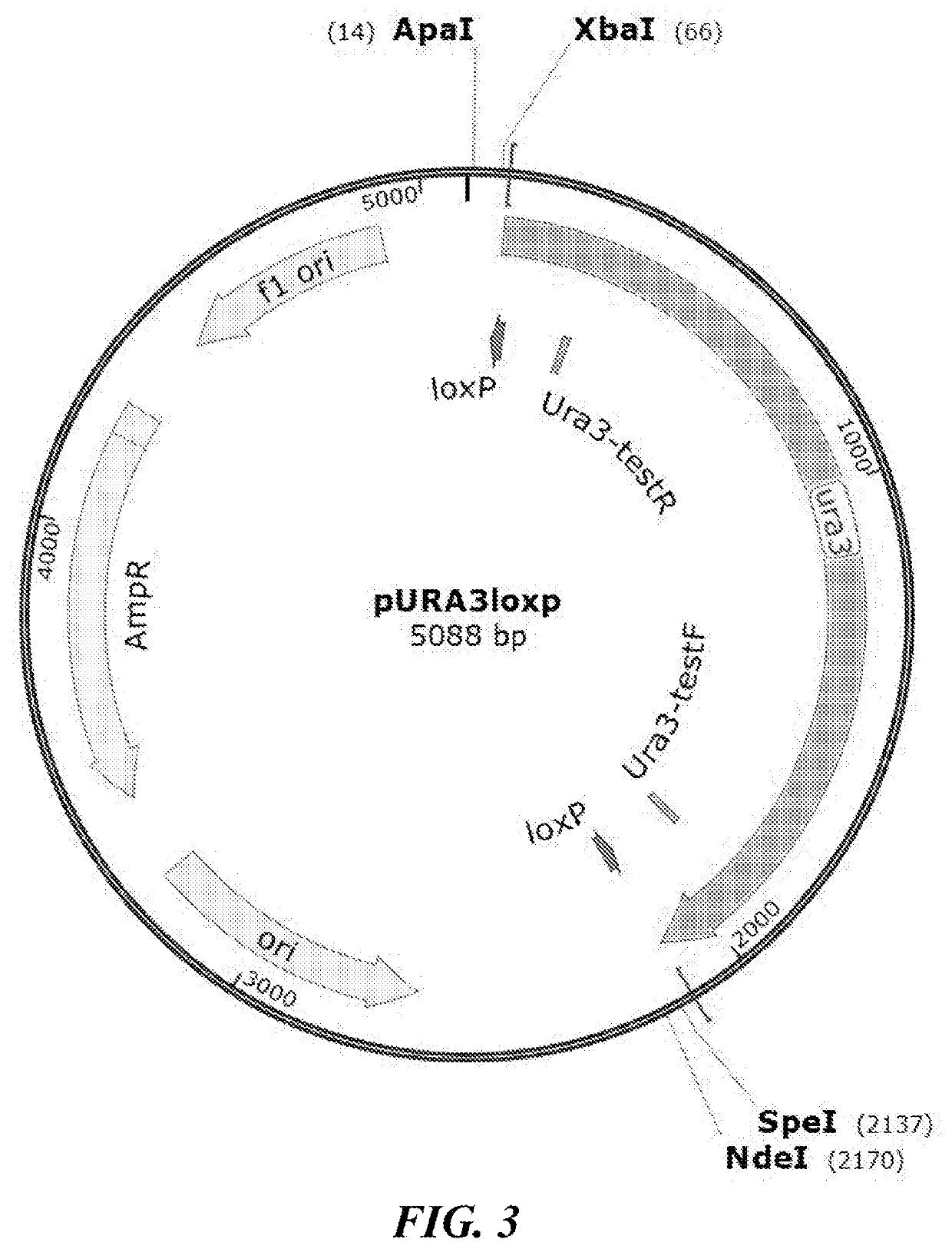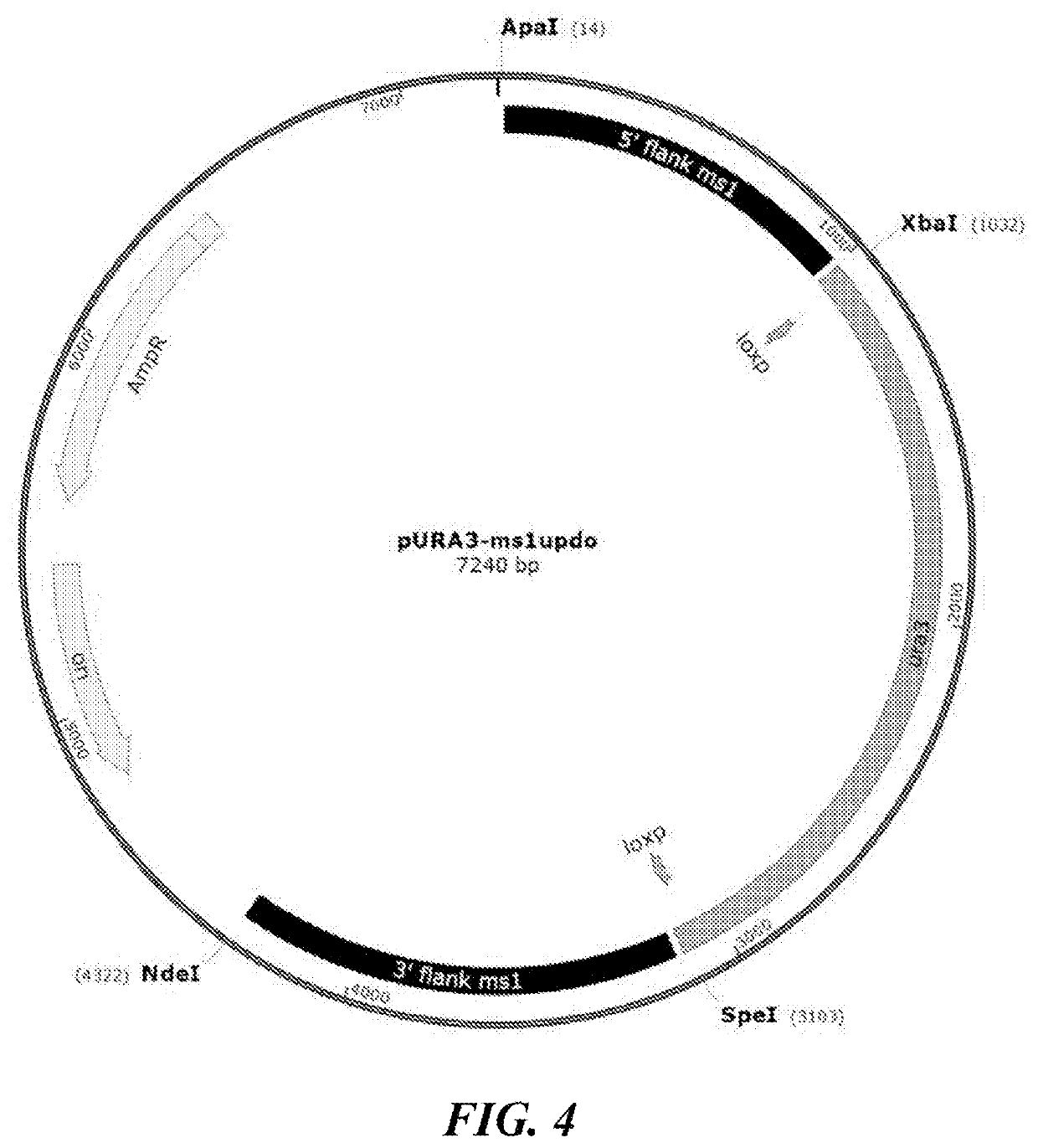Genetically engineered yeast yarrowia lipolytica and methods for producing bio-based glycolic acid
a technology of yarrowia lipolytica and yeast, which is applied in the direction of biochemistry apparatus and processes, viruses/bacteriophages, enzymology, etc., can solve the problems of large amount of base required, potential infection risk during fermentation process, and formation of undesirable by-products
- Summary
- Abstract
- Description
- Claims
- Application Information
AI Technical Summary
Benefits of technology
Problems solved by technology
Method used
Image
Examples
example 1
[0097]Deletion of Genes MS1 and MS2 Encoding Malate Synthase in Y. Lipolytica
[0098]The procedure for deletion of genes in Y. lipolytica has been provided in FIG. 6. The primers and their sequence for deletion of ins1 and ins2 can be found in Table 2. This example provides the detail protocol for deletion of genes in Y. lipolytica.
Step 1: Clone 5′ and 3′ Arms from Targeted Gene and Transform Yeast with Linearized Plasmid
[0099]A 2.03-kb DNA fragment of ura3 flanked by loxP sites was obtained by PCR by using primers ura3-F1 (SEQ ID NO 1) and ura3-R1 (SEQ ID NO 2), and genome DNA of Y. lipolytica ATCC 20460 as the template. The PCR product was then cloned into plasmid pGEM-T easy purchased from Promega Corporation according to manufacturer's manual. The resultant plasmid pURA3loxp can be used to generate the vector for disruption of the gene in Y. lipolytica Polf and its derivatives (FIG. 3),
[0100]By using genome DNA of Y. lipolytica as the template, the homologous 5′ flank of the tar...
example 2
Expression of GLYR1 From A. Thaliana in Y. Lipolytica GLO9 for Glycolic Acid Production
[0104]The Y. hpoiytica codon-optimized gene encoding GLYR1 from A. thaliana was synthesized (SEQ ID NO 17). The C E terminal tripeptide, □SRE from GLYR1 was removed during gene synthesis. At the same time, C-terminal 33-amino acid from isocitrate lyase (ICL1, YALI0C16885 g) for peroxisomal localization was fused with GLYR1, and the restriction sites of AAGCTT (for HindIII) and CCCGGG (for SmaI) were introduced into both ends of DNA fragment during synthesis.
[0105]To express gene in Y lipolytica, expression vector pYlexp1 containing a functional 0.20-kb Tef promoter and 0.58-kb xpr2 terminator was constructed (Blazeck, Liu et al, 2011). The plasmid pYlexp1 can replicate in both Y. lipolytica and E. coli because it contains yeast replication origin ORI1001, centromere (CEN) and selection marker leu2 from pS116-Cen1-1(227) (Yamane, Sakai et al. 2008) (FIG. 5), The plasmid pYlexp1 also contains three ...
example 3
Expression of Additional Genes to Improve Glycolic Acid Production
[0107]The 1.30-kb DNA fragment of ace4 encoding isocitrate lyase (ecj JW3975) from E. coil was amplified by PCR with primers EcAceA-F1 (SEQ ID NO 20) and. EcAceA-R1 (SEQ ID NO 21) by using genome DNA of E. coil K12 MG1655. The sequences of EcAceA-F1 and EcAceA-R1 are listed below.
EcAceAF1:GGCGCACTGCAGATGAAAACCCGTACACAACAAAEcAceAR1:GCAATTCCCGGGTTAGAACTGCGATTCTTCAGTGGA
[0108]The PCR product was digested with PstI and SmaI, and inserted into the digested plasmid pYlmit1 to generate pYlmit1-AceA. In plasmid pYlmit1-AceA, expression of AceA was fused with signal peptide of Cox4, so AceA. could be translocated into yeast mitochondria. Similarly, pYlmit2-G1tA was constructed to express gliA encoding citrate synthase (ecj:JW0710) from E. coli, and the expressed enzyme was present in mitochondria because of the signal peptide from OGDC used for targeting to cellular compartment. The plasmid pYlmitl-AceA was digested Xbal and Sp...
PUM
| Property | Measurement | Unit |
|---|---|---|
| temperature | aaaaa | aaaaa |
| concentration | aaaaa | aaaaa |
| concentration | aaaaa | aaaaa |
Abstract
Description
Claims
Application Information
 Login to View More
Login to View More - R&D
- Intellectual Property
- Life Sciences
- Materials
- Tech Scout
- Unparalleled Data Quality
- Higher Quality Content
- 60% Fewer Hallucinations
Browse by: Latest US Patents, China's latest patents, Technical Efficacy Thesaurus, Application Domain, Technology Topic, Popular Technical Reports.
© 2025 PatSnap. All rights reserved.Legal|Privacy policy|Modern Slavery Act Transparency Statement|Sitemap|About US| Contact US: help@patsnap.com



